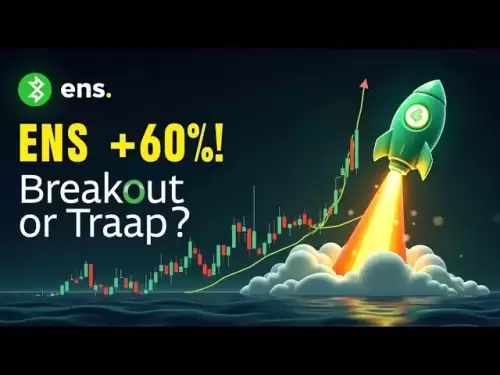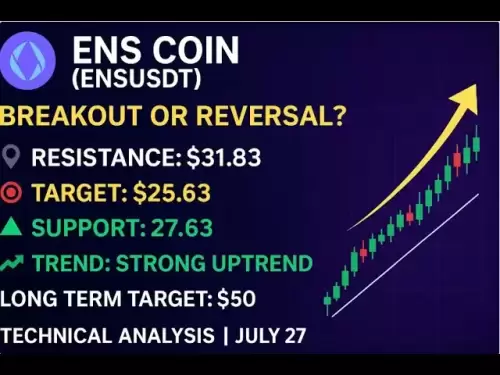-
 Bitcoin
Bitcoin $117900
0.31% -
 Ethereum
Ethereum $3766
0.28% -
 XRP
XRP $3.176
-0.31% -
 Tether USDt
Tether USDt $1.000
0.00% -
 BNB
BNB $795.6
1.51% -
 Solana
Solana $186.8
-1.09% -
 USDC
USDC $0.9999
-0.01% -
 Dogecoin
Dogecoin $0.2353
-1.33% -
 TRON
TRON $0.3226
1.49% -
 Cardano
Cardano $0.8172
-1.08% -
 Sui
Sui $4.178
3.06% -
 Hyperliquid
Hyperliquid $43.05
-3.39% -
 Stellar
Stellar $0.4367
-0.57% -
 Chainlink
Chainlink $18.62
1.47% -
 Hedera
Hedera $0.2828
6.63% -
 Bitcoin Cash
Bitcoin Cash $584.7
5.65% -
 Avalanche
Avalanche $24.81
2.53% -
 Litecoin
Litecoin $112.8
-0.88% -
 UNUS SED LEO
UNUS SED LEO $8.975
-0.08% -
 Shiba Inu
Shiba Inu $0.00001395
-1.07% -
 Toncoin
Toncoin $3.285
-1.05% -
 Ethena USDe
Ethena USDe $1.001
0.01% -
 Polkadot
Polkadot $4.123
0.76% -
 Uniswap
Uniswap $10.49
-0.18% -
 Monero
Monero $326.5
0.14% -
 Dai
Dai $0.9999
-0.02% -
 Bitget Token
Bitget Token $4.576
0.34% -
 Pepe
Pepe $0.00001247
-1.55% -
 Cronos
Cronos $0.1400
3.77% -
 Aave
Aave $295.1
-0.73%
What are DeFi derivatives? How to hedge risks?
DeFi derivatives enable speculation on crypto prices without holding assets, offering risk management through futures, options, swaps, and perpetual contracts on blockchain platforms.
May 19, 2025 at 02:42 am
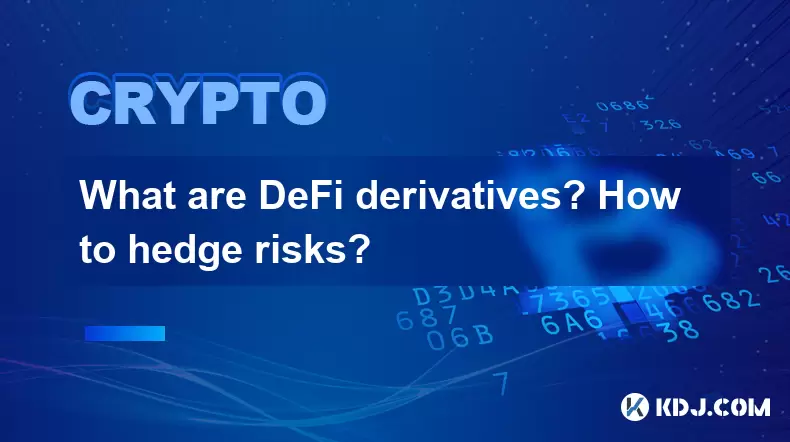
DeFi derivatives are financial instruments that derive their value from an underlying asset or a group of assets within the decentralized finance ecosystem. These instruments can include futures, options, swaps, and perpetual contracts, among others. DeFi derivatives allow users to speculate on the price movements of cryptocurrencies and other digital assets without needing to hold the actual assets themselves. This provides a way for traders to gain exposure to the market while potentially managing their risk exposure.
Understanding DeFi Derivatives
DeFi derivatives are a critical component of the decentralized finance ecosystem. They function similarly to traditional financial derivatives but operate on blockchain networks, ensuring transparency and reducing the need for intermediaries. The most common types of DeFi derivatives include:
Futures Contracts: These are agreements to buy or sell an asset at a future date for a price agreed upon today. In DeFi, futures contracts are often used to speculate on the future price of cryptocurrencies.
Options: These give the holder the right, but not the obligation, to buy or sell an asset at a specified price within a certain timeframe. DeFi options can be used for hedging or speculative purposes.
Swaps: These are contracts where two parties exchange cash flows or liabilities from two different financial instruments. In DeFi, swaps are often used for interest rate swaps or token swaps.
Perpetual Contracts: These are futures contracts with no expiration date, allowing traders to hold positions indefinitely. They are popular in DeFi for their flexibility and the ability to use high leverage.
How DeFi Derivatives Work
DeFi derivatives operate on smart contracts, which are self-executing contracts with the terms directly written into code. These smart contracts are deployed on blockchain platforms, such as Ethereum, and can be accessed by anyone with an internet connection. Here's how they typically work:
Collateralization: Users must lock up collateral to open a position in a DeFi derivative. This collateral is used to cover potential losses if the market moves against the user's position.
Price Oracles: These are third-party services that provide real-time price data to the smart contracts. They ensure that the derivatives' prices reflect the current market conditions.
Liquidation: If the value of the collateral falls below a certain threshold, the position may be liquidated to prevent further losses. This process is automated and handled by the smart contract.
Hedging Risks with DeFi Derivatives
Hedging is a strategy used to offset potential losses in one position by taking an opposite position in another. In DeFi, derivatives can be used to hedge against the volatility of cryptocurrencies. Here's how you can hedge risks using DeFi derivatives:
Using Futures Contracts: If you hold a cryptocurrency and are concerned about a potential price drop, you can sell a futures contract at the current price. If the price does fall, the profit from the futures contract can offset the loss in the underlying asset.
Options for Hedging: Buying a put option gives you the right to sell an asset at a specified price, which can protect against a decline in the asset's value. Conversely, a call option can be used to hedge against a rise in the price of an asset you owe.
Swaps for Risk Management: Interest rate swaps can be used to hedge against fluctuations in borrowing costs, while token swaps can help manage exposure to different cryptocurrencies.
Perpetual Contracts for Flexible Hedging: These can be used to hedge against short-term price movements without the need to commit to a specific expiration date.
Practical Steps to Hedge with DeFi Derivatives
To hedge risks using DeFi derivatives, you can follow these detailed steps:
Choose a DeFi Platform: Select a reputable DeFi platform that offers the derivatives you need. Popular platforms include dYdX, Synthetix, and Perpetual Protocol.
Connect Your Wallet: Use a compatible cryptocurrency wallet, such as MetaMask, to connect to the DeFi platform. Ensure you have enough funds in your wallet to cover the collateral requirements.
Select the Derivative: Decide which type of derivative you want to use for hedging. For example, if you want to hedge against a potential price drop in Bitcoin, you might choose a Bitcoin futures contract or a put option.
Open a Position: Navigate to the trading section of the platform and select the derivative you want to trade. Enter the amount you wish to hedge and review the collateral requirements.
Set Up Collateral: Deposit the required collateral into the smart contract. This amount will depend on the size of your position and the platform's margin requirements.
Monitor and Adjust: Keep an eye on the market and your position. If the market moves in your favor, you can close the position to realize profits. If it moves against you, you may need to add more collateral to avoid liquidation.
Close the Position: When you are ready to close your hedge, navigate back to the trading section and execute the closing trade. The smart contract will automatically handle the settlement.
Risks and Considerations
While DeFi derivatives offer powerful tools for hedging, they also come with significant risks. Understanding these risks is crucial for effective risk management:
Volatility: Cryptocurrency markets are highly volatile, which can lead to rapid changes in the value of your positions. This volatility can work both for and against your hedging strategy.
Smart Contract Risks: The smart contracts that power DeFi derivatives are not immune to bugs or hacks. A vulnerability in the code could lead to the loss of your collateral.
Liquidity Risks: Some DeFi platforms may have low liquidity, making it difficult to enter or exit positions quickly. This can impact your ability to hedge effectively.
Regulatory Risks: The regulatory environment for DeFi is still evolving, and changes in regulations could impact the availability or legality of certain derivatives.
Frequently Asked Questions
Q: Can I use DeFi derivatives to hedge against multiple cryptocurrencies simultaneously?
A: Yes, you can use DeFi derivatives to hedge against multiple cryptocurrencies. Platforms like Synthetix allow you to trade synthetic assets that track the price of various cryptocurrencies, enabling you to hedge a diversified portfolio.
Q: What is the difference between a centralized and decentralized derivative?
A: Centralized derivatives are offered by traditional financial institutions and require intermediaries, whereas decentralized derivatives operate on blockchain networks and are executed via smart contracts, reducing the need for intermediaries and increasing transparency.
Q: How do I know if a DeFi platform is safe to use for hedging?
A: To assess the safety of a DeFi platform, consider factors such as the platform's reputation, the security of its smart contracts (often audited by third parties), the transparency of its operations, and the liquidity of its markets. Always conduct thorough research before committing funds.
Q: Can I hedge against stablecoins using DeFi derivatives?
A: Yes, you can hedge against stablecoins using DeFi derivatives. Platforms like dYdX offer perpetual contracts on stablecoins, allowing you to speculate on or hedge against their price movements relative to other assets.
Disclaimer:info@kdj.com
The information provided is not trading advice. kdj.com does not assume any responsibility for any investments made based on the information provided in this article. Cryptocurrencies are highly volatile and it is highly recommended that you invest with caution after thorough research!
If you believe that the content used on this website infringes your copyright, please contact us immediately (info@kdj.com) and we will delete it promptly.
- Cryptos to Watch in 2025: Punisher Coin, Chainlink, and the Altcoin Arena
- 2025-07-27 18:30:13
- Bitcoin, Altcoins, Rebound: Navigating the Crypto Comeback Trail
- 2025-07-27 18:30:13
- Ethereum, Bitcoin, and Altcoins: A Shift in Crypto Tides?
- 2025-07-27 19:10:13
- Windtree Therapeutics' Bold BNB Strategy: A $520 Million Crypto Play
- 2025-07-27 19:10:13
- Solana, Staking, and Unilabs: What's the Buzz in the Crypto Space?
- 2025-07-27 16:50:13
- VeChain, HBAR, Remittix: Navigating the Crypto Landscape in 2025
- 2025-07-27 17:10:12
Related knowledge
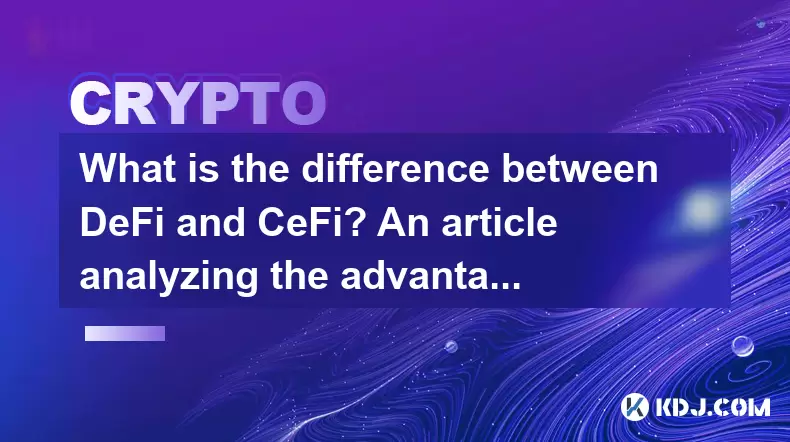
What is the difference between DeFi and CeFi? An article analyzing the advantages and disadvantages of both
Jun 13,2025 at 03:57am
Understanding the Foundations of DeFi and CeFiTo fully grasp the difference between DeFi (Decentralized Finance) and CeFi (Centralized Finance), it’s ...
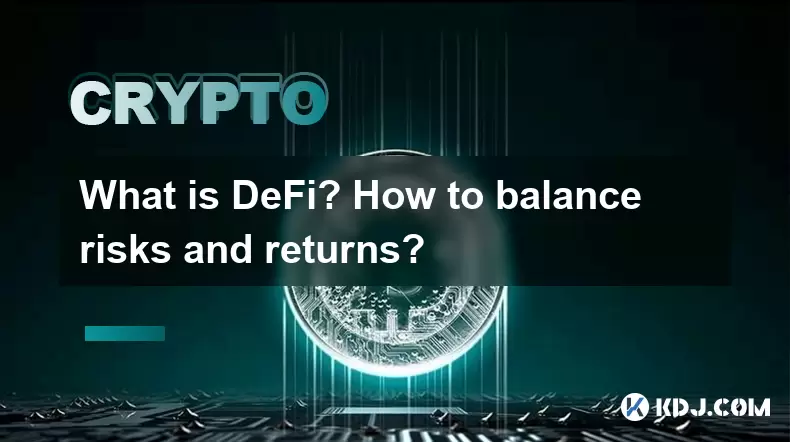
What is DeFi? How to balance risks and returns?
May 31,2025 at 12:22pm
What is DeFi? How to Balance Risks and Returns? Decentralized Finance, commonly known as DeFi, represents a revolutionary shift in the financial ecosy...
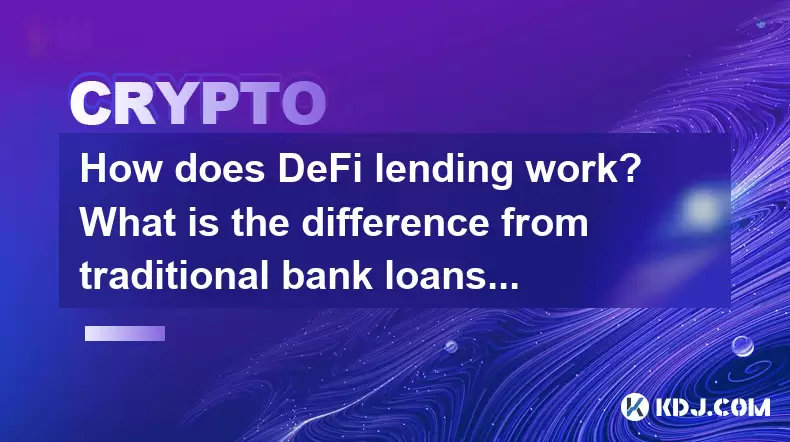
How does DeFi lending work? What is the difference from traditional bank loans?
May 29,2025 at 05:36pm
Introduction to DeFi LendingDeFi lending, or decentralized finance lending, represents a revolutionary shift in the way borrowing and lending are cond...
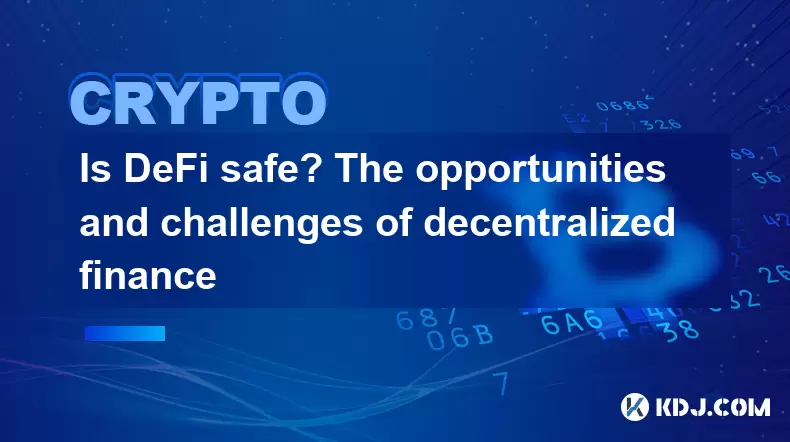
Is DeFi safe? The opportunities and challenges of decentralized finance
May 27,2025 at 02:28pm
Decentralized Finance, commonly known as DeFi, has revolutionized the financial landscape by offering a range of financial services without the need f...
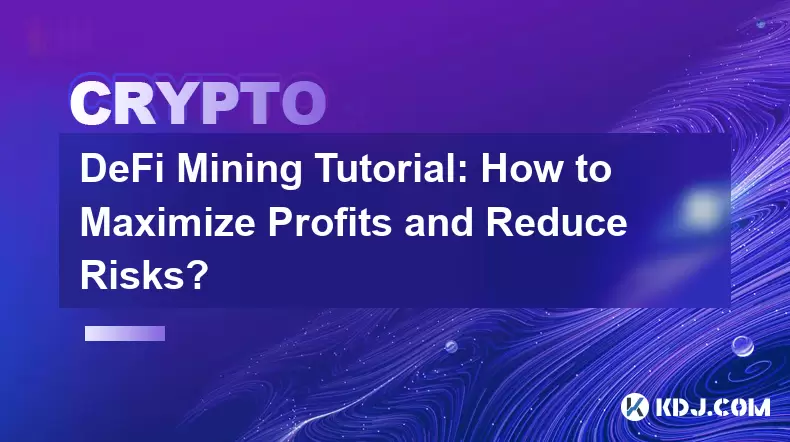
DeFi Mining Tutorial: How to Maximize Profits and Reduce Risks?
May 27,2025 at 07:42am
DeFi, or Decentralized Finance, has opened up a new world of opportunities for crypto enthusiasts looking to maximize their profits through various mi...
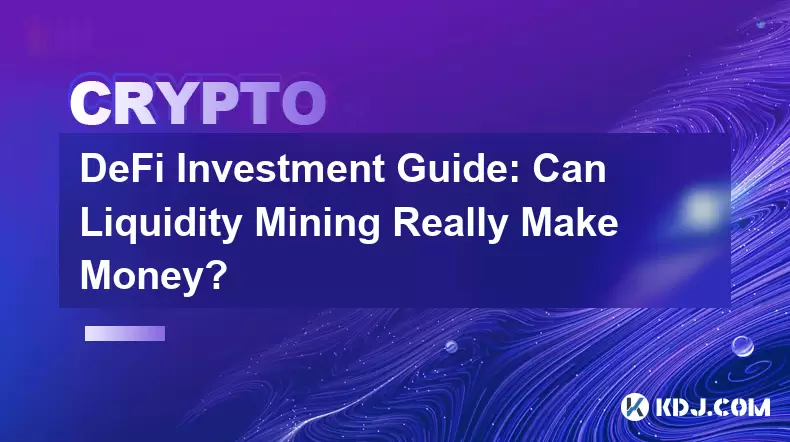
DeFi Investment Guide: Can Liquidity Mining Really Make Money?
May 28,2025 at 10:18am
Introduction to Liquidity Mining in DeFiLiquidity mining has emerged as a popular method for earning passive income within the decentralized finance (...

What is the difference between DeFi and CeFi? An article analyzing the advantages and disadvantages of both
Jun 13,2025 at 03:57am
Understanding the Foundations of DeFi and CeFiTo fully grasp the difference between DeFi (Decentralized Finance) and CeFi (Centralized Finance), it’s ...

What is DeFi? How to balance risks and returns?
May 31,2025 at 12:22pm
What is DeFi? How to Balance Risks and Returns? Decentralized Finance, commonly known as DeFi, represents a revolutionary shift in the financial ecosy...

How does DeFi lending work? What is the difference from traditional bank loans?
May 29,2025 at 05:36pm
Introduction to DeFi LendingDeFi lending, or decentralized finance lending, represents a revolutionary shift in the way borrowing and lending are cond...

Is DeFi safe? The opportunities and challenges of decentralized finance
May 27,2025 at 02:28pm
Decentralized Finance, commonly known as DeFi, has revolutionized the financial landscape by offering a range of financial services without the need f...

DeFi Mining Tutorial: How to Maximize Profits and Reduce Risks?
May 27,2025 at 07:42am
DeFi, or Decentralized Finance, has opened up a new world of opportunities for crypto enthusiasts looking to maximize their profits through various mi...

DeFi Investment Guide: Can Liquidity Mining Really Make Money?
May 28,2025 at 10:18am
Introduction to Liquidity Mining in DeFiLiquidity mining has emerged as a popular method for earning passive income within the decentralized finance (...
See all articles





















